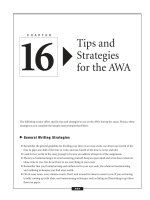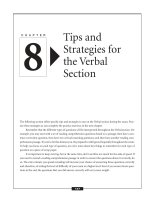100 Tips and Techniques for Getting the Job Done Right by Tom Kendrick_4 pptx
Bạn đang xem bản rút gọn của tài liệu. Xem và tải ngay bản đầy đủ của tài liệu tại đây (339.9 KB, 9 trang )
evant to the needs of all the relevant personnel con-
cerning every tool available – more will be said on this
topic later.
.. The Tool Management
Infrastructure
Whenever a tool management system has been devel-
oped, an organised and well-planned tool preparation
facility is vital to prepare the specic tooling require-
ments – o-line, so that tooling might be:
•
Built to pre-dened assemblies – from a range of
standardised stocked parts, or from tool modules,
•
Replacing worn cutting inserts on used tooling as-
semblies – these tools being returned for rebuild-
ing, or servicing,
•
Measuring tool osets – then, when it is both
timely and appropriate, sending tooling in the form
of tool-kits to specied machine tools,
•
Inspecting tooling – normally undertaken on tool
pre-setters and by visual means, to ensure that they
are t for immediate use,
•
Assembling: tooling, xtures, gauges, etc., as a
‘complete tool-kit’ – to be issued to the appropriate
machine tool at the correct time.
In order to ensure that consistent and accurate tool
preparation occurs, a documented ‘historical proce-
dure’ covering all tooling-related aspects, is necessary,
such as: tool inspection, servicing and building, is re-
quired for each tool. ese factors can be controlled
by utilising a computerised tool management system,
as only the data les will need to be updated, together
with tooling assembly instructions, with both servic-
ing and inspection being undertaken by a step-by-step
approach – if needed. Many of the more sophisticated
tool management systems currently available, oer
a link back to the original Computer-aided Design
(CAD) soware, allowing tools to be shown graphi-
cally assembled as tool parts.
As the these tools travel around the machining
facility, through various stages of preparation and
measurement, then assembled as ‘qualied tool-kits’
visiting machine tools and then travelling back to
the tool preparation area for re-servicing, each stage
of the tool-kit’s cycle must be controlled. Informa-
tion concerning the tool kit’s progress, must be avail-
able at any instant and, a means of exercising control
is to link each tooling station to a central computer
via a DNC-link. As the unique data referring to any
tool is stored within the central computer, its identity
can be accessed allowing its ‘logistical progress’
22
to be
precisely tracked within the manufacturing facility.
For some companies that are unable to justify such a
complex tool management method of tooling control,
then a much less costly and simpler ‘manual system’
using either printed labels, or bar-codes can be de-
ployed for tool identication when delivering tooling
to-and-from the required machine tool. A cautionary
note concerning the use of paper labels for tool identi-
cation, is that they can more easily become detached
during the machining cycle.
In an automated machining environment, there is
no real alternative but to have a ‘tooling requirement’
and in particular, employing some form of ‘intelligent/
tagged’ tooling, typically via permanent machine-
readable tool identication. Such tool identication
techniques, allow the necessary data to be interrogated
and retrieved from critical areas around the produc-
tion facility: machine tools, preparation area and stor-
age, plus other peripheral areas – as required. Tooling
equipped with ‘intelligent’ memory circuits embed-
ded within them (i.e. typically shown in the case of
the non-rotating ‘Block tooling’ in: Figs. 116, 117 and
118), can automatically perform the functions of: tool
identication, tool osets and cutting data up-dating
on the machine tool. Other information complement-
ing the tooling data-base pertaining to tool servicing
needs can also be exploited by using these ‘tool-coded
data chips’ , which are securely situated within the
‘front-end’ of each tool.
So that ‘complete tooling control’ is maintained
over all the items necessary relating to tool-kits, it is
possible to extend stock control over all the tooling
requirements out on the shop oor (Fig. 131). Such
tool-tracking is important and certain logistical ques-
tions must be known, such as: what tooling is where, is
it timed to be there now and, what is its present con-
dition, together with other specic questions, which
22 ‘Logistical information and knowledge’ , in any production
environment is vital and has been dened (i.e. by the Council
of Logistics Management – CLM), in the following manner:
Logistics is the process of planning, implementing and control-
ling the ecient, cost-eective ow and storage of: raw material,
in-process inventory, nished goods and related information,
from point of origin to point of consumption for the purpose of
conforming to customer requirements.’
Chapter
need to be addressed, indicating the complex task of
monitoring all tooling, via a computerised tool man-
agement system (Fig. 132). Tool control soware en-
ables these physical transactions associated with the:
tooling, servicing, kitting, recalibration, etc., to be
achieved, without loosing track of any individual tool
items. e tooling soware will also continuously
monitor stock levels, allowing replenishments be ac-
tioned, once any itemised tool stock level falls below a
certain pres-set value.
Figure 131. Tooling and xturing must be precisely controlled at the ‘focal-point’ of kit build-up/replenishment – at the tool
preparation area. [Courtesy of Sandvik Coromant]
.
Modular Tooling and Tool Management
Obviously, it is important to create a suitable tool
management system, that can operate successfully in a
company’s machine shop and it needs to be customised
to suit their particular tooling requirements from a
relevant database. ese tooling-related matters, will
form the basis for a discussion in the following sec-
tion.
.. Creating a Tool Management
and Document Database
Production Requirements
Prior to any new machining activities being under-
taken and, in order to establish the ‘true’ production
requirements of a company, it is essential that co-
operation and information regarding the customer’s
potential product occurs. More specically, this de-
tailed dialogue should be between both the sales and
manufacturing departments. e rst requirement is
an understanding of the manufacturing load, typically
these being broken-down into the following batch and
volume classications
23
:
•
Job shop – one-, or two-o specialised workpieces,
23 Optimum/economic batch size, this will vary, but if batch size
is graphically-plotted against cost , for values of set-up cost and
holding cost, then the overall total variable cost can be derived,
with the lowest plotted value representing the minimum cost
batch size ‘Q*’ (i.e. derived from R.Wild’s book: Production
and Operations Management, Chap. 14 – see References), as
follows:
Q* = √ 2C
s
r/C
1
Where: Q* = minimum cost batch size, C
s
= set-up, or prepara-
tion cost/batch, r = consumption rate, C
1
= stock-holding cost/
item/unit of time.
Figure 132. Ecient tool management of tool kits around the manufacturing facility, requires some form of ‘tool tracking and
identication’ – as ‘kits’ are: serviced and built, measured, the sent to an awaiting machine tool. [Courtesy of Sandvik Coromant]
.
Chapter
•
Small batch – up to perhaps 50 workpieces,
•
Medium batch – between 20 to 100 workpieces,
•
Large batch/Volume production – >100 work-
pieces.
NB ese classications of batch size are open to
considerably much wider interpretation, obviously
depending upon a specic company’s production
requirements and the actual machined part’s: com-
plexity, material cost, machining operations and its
dimensional size and so on!
At any workpiece quantity greater than the ‘Job shop’
levels having similar production processes undertaken,
allows them to be grouped into ‘families’ , according
to their: dimensions, tolerances, workpiece materials,
etc. is technique of allocating components to be ma-
chined into similar groupings is oen termed ‘Group
Technology’
24
.
It is vitally important that both the Sales and Mar-
keting personnel are aware of the company’s patterns
of manufacture and their capabilities, if the company
is to be able to rapidly respond to their customer’s
needs. e sales force will be able to relate a customer’s
requirements to the standard range of parts produced,
with the manufacturer being in a position to ‘ne-tune’
even small production runs for maximum eciency.
By comprehending the manufacturing process for the
company’s standard-ranges, allows the optimum con-
ditions of production to be utilised, even when ‘modi-
ed standards’ , or even ‘specials’ have to be produced.
Flexibility here, plus the ability to cater for unique cus-
tomer needs, may oer new market opportunities for
the company.
24 ‘Group Technology’ (i.e. GT), is essentially utilised for ‘group-
ings’ in two distinct varieties:
(i) Component geometry – the ‘closeness of shapes’ ,
(ii) Similar production processes – such as: Milling, Drill-
ing, Turning, etc. e benets of utilising a GT-approach to
manufacture are: smoother logistical work-ow, simplied
work control, more ecient plant layout and improved use
of oor-space, contributing to enhanced manufacturing
versatility and better response to variable workpiece shop-
loadings.
NB e GT-approach to manufacturing lends itself to compo-
nent coding systems, typically of the Opitz variety for a unique
part-coding classication.
Perishable and Capital Equipment Review
In many cases, cutting tool manufacturers produce
standard forms to enable companies to compile data
on both their perishable and capital equipment needs.
erefore, it is necessary to gather the data together,
because the performances of either categories are
independent. If a tooling survey is approached in a
methodical and step-wise manner, then the following
sequence, may be of some help:
•
Collect data on perishable tooling, a company
must analyse their entire tool-ow system, includ-
ing tooling inventories: high-lighting the maximum
and minimum levels, quantities of new and used
tooling, together with their tool-storage require-
ments. As a preliminary data-gathering exercise, all
the items in stock should be listed, plus the number
currently in stock and, the quantity used in the last
12 months, with the last price paid for them,
•
Review the stock lists for tool obsolescence, by
checking to see which items have not been used in
the last 12 months and which can be replaced by
say, an ANSI, or DIN standard item. Any tools fall-
ing into this category, can be considered obsolete, it
would not be a surprising fact to nd out that up to
50% of the current tooling inventory was obsolete
– as has been shown in a survey in the USA. is
level of obsolescence, can be regarded as money
‘tied-up’ and doing nothing for the company’s prof-
itability,
•
Remaining ‘tooling items’ should now be reviewed,
as these are not obsolete. For example, the cemented
carbide insert grade of tooling, should be grouped
according to their grade/coating, size, geometry,
etc., then once they have been ‘grouped’ in this
manner, it is now perhaps possible to order larger
quantities of them, enabling the company to exert
some ‘leverage’ over their suppliers and to obtain
substantial cost advantages as a result.
NB If tooling information of this nature is com-
piled and regularly up-dated, then reviewed, future
tooling decisions can be speeded-up and decisions
can be taken with some degree of condence.
e compiling of information concerning capital equip-
ment within the factory, usually commences with the
preliminary identication of such machine tools and
associated equipment, then numbering them (i.e. this
activity is oen termed: ‘brass-tagging’) and their spe-
Modular Tooling and Tool Management
cic location within the company’s premises. A list is
then compiled, allocating every machine tool’s: power
capacity, spindle taper, number of spindles, its current
operating condition
25
, present tooling utilised, plus the
current and past operations performed on each ma-
chine tool. By organising information concerning the
capital equipment capability and availability, produces
a number of distinct benets, including a knowledge of
the machines basic characteristics, thus ensuring that
the most advantageous machine tool can be selected
and any machining operation is performed using the
optimum parameters.
Knowledge gained from such a study of perishable
and capital equipment, allows for improvements in
both: process planning – the action plan for the manu-
facturing of a certain part, together with production
planning – the best use of a factory’s resources for a
particular workload.
Building-Up the Tool File
Probably the principal users of a tool le within any
manufacturing organisation are the Process Engineer
and Part-programmer, with perhaps the Tool-preset-
ting operator and Stores-personnel, also making use
of this ‘le’. It should be stressed that new tools are
only added to the tool le aer a proper investigation
of the need for them, assuming that such tooling was
not previously listed. By accepting this limitation on
25 ‘Operating condition’ , this machine tool activity is invariably
of some concern, as although some form of periodic mainte-
nance is likely to be undertaken, perhaps less attention is given
to the machine’s current state of calibration. is situation can
be diagnostically-achieved, both speedily and eciently by
the use of telescoping ‘Ball-bars’. is calibration equipment
can undertake a quick ‘health-check’ and assess both the static
and dynamic machine tool’s performance, indicating the fol-
lowing important characteristics: Servo-mismatch, Stick-slip,
Reversal spikes, Scale uncertainty, Straightness, Squareness,
Lateral play, Back-lash, Cyclic error. ese machine tool re-
lated-factors are automatically prioritised by the soware,
then they can then be simply: analysed, diagnosed and then
corrected, together with a machine tool ‘health-check’ report.
NB Many companies perform these full diagnostic ‘health-
checks’ , periodically, or simply prior to a shi commencing,
as they can be undertaken in just a few minutes for a ‘quick
assessment’ , or perhaps a more thorough ‘Ballbar’ assess-
ment can be achieved in just a few hours – when a convenient
‘maintenance window’ occurs.
the number of dierent tools in the tooling inventory,
then a company can be assured that when the tools are
‘called-up for use’ in the manufacturing process they
will be available and backed-up with spares, since the
‘stores’ has access to this ‘le’. An important feature of
any tool le is the cutting data and machining times
listed. ese machining data are known to be achiev-
able and will be those values expected to be employed
during component production. More specically, the
data values are the ones utilised to calculate quotation
prices for the product, for any future customer ap-
praisal. e editor of the tool le has a key role to play
in the acquisition of tooling data, so when building up
the ‘le’ , they have to:
•
Scrutinise any reported deviations – from the re-
corded cutting data and the original tool le,
•
Investigate higher productivity ratings – some
newly-available tooling may lay claim to be both
faster and more ecient in comparison to either its
predecessor, or competitors tooling products,
•
Obsolete tooling should be ‘weeded-out’ – particu-
larly with the introduction and addition to the tool
le of newer high-technology tooling,
•
Investigation of new tooling – to see if claims of
new tooling products, with regard to their: geom-
etry, coatings, performance, etc., are a genuine im-
provement over the previous versions used.
e systematic accumulation of tooling knowledge in
the tool le for each section of the manufacturing
operation, ensures that the cutting performance will
‘continuously improve’
26
. Such improvements may be
considered to be analogous to improving the skill of
an operator on a conventional machine tool, but with
more exibility, as the tool le system soware is able
to cope with much more diverse and complex tooling
26 Continuous improvement programs’ , were originally devel-
oped in Japan and are now well-known and are oen termed
‘Kaizen’ *, which is a philosophical and rigorous approach to
process/product improvements, based upon:
(i) Satisfying the customers – in order to keep the business
alive and to be more protable,
(ii) Being both customer- and process-oriented – to promote
vigorous improvements here,
(iii) Requiring commitment and participation of a company’s
personnel – using their knowledge and experience to achieve
continuous improvements in both working practices and in
the product’s quality.
*In Japanese, Kaizen, approximates to: ‘Change to the better’.
Chapter
situations. A ‘well-disciplined’ and ‘active’ tool le,
completely eliminates the anticipated ‘hiccups’ that are
likely to occur, whenever a new Part programmer is
employed, or even when hiring new Stores personnel,
or Machine operators, for that matter!
With the soware structure of the tool le – of
necessity – being highly complex and interrelated in
nature, it is not possible within the connes of this
chapter to go into too much detail showing how the
operating system works. However, an appreciation of
a simpler, but still valid tool le format can be gleaned
by describing how a ‘manual le’ is produced. Prior to
constructing this manual tooling data-base, a separate
record is produced for each tool, which is cross-refer-
enced to separate cards for cutting inserts that can be
utilised with the tool. In essence, there are four ‘elds
of tooling information’ that are needed for a usable tool
le, these are:
1. Tooling is built-up from modular elements – which
are the ‘key’ to eective management and control,
as they allow the widest range of tooling for an ex-
tensive assortment of machine tools available, from
the minimum number of tooling elements in stock.
Hence, a tool for a given machining application may
be assembled from dierent modular elements, to
suit a range of machines,
2. Materials Requirement Planning (MRP)
27
– the
system together with the tool stores should support
the tooling from the tool le, with such items as:
spares, consumables, plus back-up tooling. In order
to achieve this objective, the tool le record would
include details of the build-up for each tool as well
as the stores location for each part, using a specic
‘key’ notation,
27 ‘Materials Requirement Planning’ (MRP*), is a soware-
driven system that enables manufacturing companies to
calculate: how many materials are needed, what particular
types that are required, plus at what times they are needed. To
achieve this level of control, the system utilises a sales order
book, which records known future orders and also a ‘fore-
cast’ of what sales orders the business is reasonably condent
it might have won. en, the MRP soware interrogates and
checks all the ‘components/ingredients’ which are required to
make these future orders and ensures that they are ordered in
time.
*MRP, was originally developed in the 1960’s and is some-
times termed MRPI, to dierentiate it from the ‘derived’ MP-
RII system – see Footnote 18.
3. Certain ‘steering comments’ on tooling – normally
these statements are based upon shop-oor expe-
rience, that are included to enable the Process-, or
Planning-engineer to select the appropriate tool for
the desired machining application,
4. Organisation of basic cutting data – this is nor-
mally produced so that the data can readily be in-
cluded into the CNC program.
NB is cutting data is organised according to the
component to be machined and the optimum or-
ganisation of this machining data will vary from
one company to another, depending on their needs.
Of course, all of this data listed reects the compa-
ny’s actual experience, in particular, it includes the
results of any ‘optimisation exercises’ (i.e. Machin-
ability trials – more on this later) previously under-
taken in the machine shop.
Practicalities when Starting-Up a Tool File
Whenever a tool le system is initiated, the important
point to observe is to: start small and keep the tooling
information to be included ‘sound’. Having accepted
this principle, a company may start to build-up the
tool le steadily – over perhaps a month, including
any practical test data for maybe a hundred, or so of
the most popular tools utilised. is information now
residing within the tool le, will ow through the tool-
management system and, it will begin to highlight
the requirements of the system users, driving forward
the le’s further development. Conversely, a company
may embark on a more comprehensive tool le sys-
tem, incorporating all the machining data available on
perhaps two thousand tools, but utilising provisional
cutting data, instead of well-proven information. With
this rather heavy-handed and rapidly-built tool le
approach, the probable outcome will mean that the
whole ‘le’ has incorporated many ‘dud tooling solu-
tions’ , thereby ensuring that the system is discredited,
even before it is correctly operating at anywhere near
its optimum level.
Obtaining meaningful test results and tool assess-
ments does not necessarily demand extra eort from
the company, merely the organisation of endeavour
already being made by the company’s ‘Tooling-engi-
neers’ and those from the tool suppliers. Oen, most
of the tooling trouble-shooting activities will dissipate
once the current component batch is completed, sim-
Modular Tooling and Tool Management
ply because there is no framework in which this vital
information can be recorded – for future usage. So,
all the time and pain’s-taking eort needed to collate
‘sound’ tooling data is disregarded and the informa-
tion is discarded. So, when then a repeat batch order
duly arrives, the whole tooling-related data-gather-
ing process must once again begin, by ‘re-inventing
the wheel’ – this being a total and unnecessary, but is
costly waste of everybody’s time!
Tool-kitting servicing to the machine shop must
be based upon the assurance that the completed kits
are dependable, whilst providing the maximum secu-
rity from a limited budget for tooling stock. Usually
there is a nite tool stock available, with the objec-
tive being to utilise, for example, the same modular
tools across a range of machine tools. For this reason,
modular quick-change tooling, has seen a widespread
acceptance by machining-based companies of late.
Yet another important factor in any tooling requisi-
tion for a specic machining operation, is the inherent
quality of the tools used. One of the major function’s
of the tool-kitting area, is to monitor and control the
quality of delivery of tooling within the manufactur-
ing environment, by accessing the ‘tool data ow’ for
both out-going ‘new kits’ and in-coming tooling ‘old
kits’ from completed production runs. As batch sizes
become smaller, the ‘logistical-ow’ of kits speeds-up.
e eectiveness of the tool-kitting personnel will be
inversely-proportional to the number of tooling items
on the inventory and the ‘standard’ they must control.
is problem of eective tool control, is a further ar-
gument in favour of a factory-wide standardisation of
the tooling inventory. erefore, in summing up tool-
ing-related activities within the production location,
two main factors emerge, these are:
1. Linking every tool with its application technology
– this is normally achieved in such a manner that it
is the most productive tools that are chosen for new
jobs and not the old ones – just because they have
been previously used and are known to be sup-
ported by the tool stores. is tool selection strat-
egy, will result in the optimum cutting conditions
being selected,
2. Formulating a rationalised and optimised tool
management ‘standard’ – this is essential as it sup-
ports tooling across the breadth of the whole fac-
tory.
NB When purchasing any new tooling, or machine
tools, reference to this ‘standard’ is of the essence
for the overall system to operate eectively.
.. Overall Benefits of a Tool
Management System
By the correct implementation of a basic, but compe-
tent tool management control system, the following
list highlights the ‘rewards’ that can be expected:
•
Manpower is conserved and training requirement
minimised,
•
e number of tools lost, or misplaced is reduced,
•
Timely and up-to-date information on tool usage is
produced,
•
Tool inventory shortages are identied and pre-
vented,
•
e accuracy of the tooling inventory is improved,
•
Inventory levels and excess purchasing are mini-
mised,
•
Time spent on re-ordering, etc., plus ‘piecemeal
purchasing’ are reduced,
•
Record-keeping functions are consolidated,
•
Tool tracking and tooling availability within the
machine shop is monitored,
•
Tools in rework can be tracked,
•
A record of scrapped tools can be kept,
•
Obsolete tooling can be identied and then elimi-
nated,
•
e cost of the total tooling inventory can be criti-
cally-assessed,
•
e gauges and xtures supplied with the tool kits
can be identied and tracked,
•
Machine tool set-up, tool-return and withdrawal
times are reduced,
•
Possibility of pin-pointing over-use machining
problems, by specic personnel,
•
Improper charge-outs, losses, or pilferage can be
minimised,
•
Space requirements and overheads are reduced,
•
Possibility of incorporating existing tool numbers
and current mode of operation into an automated
system, without making radical changes.
Tool management systems provide all of the above
benets, by allowing the operations to be easily re-
ported, analysed and corrected, enabling timely de-
cisions to be made, concerning the tooling, with the
minimum of manpower and operational changes
necessary. So that the information required by a com
-
pany can be obtained, the system should be organised
to allow personnel responsible for the tools to record
their activities. On the ‘shop oor’ , it is the usual prac
-
tice to allow two basic groups of the workforce levels
of responsibility/access to the system to provide both
Chapter
vital and helpful tooling information, these are the:
Tooling-supervisor and Stores personnel.
So far, the information on Tool management sys-
tems has been principally concerned with the justi-
cation and benets that accrue through the adoption
by a company and the philosophy underpinning its
practical application. In the ‘continuous circle’ of tool
monitoring and control, the tool-kitting area is at the
‘heart’ of the overall tool management procedure. is
vital day-to-day activity of tool preparation and set-
ting, will be the subject of the following section.
.. Tool Presetting Equipment
and Techniques
for Measuring Tools
Introduction
Cutting tools that are to be utilised on CNC machine
tools for the production of workpiece features, need to
have exact measurement information regarding their
osets known, so that the CNC program can automati-
cally displace (i.e. oset) the tool these dimensional
distances, in order to perform the intended machining
task. Otherwise, major errors in the machined com-
ponent’s dimensional features would result. Hence,
cutting tooling can be classied under three distinct
headings, these are:
1. Unqualied tools – these are tools that do not have
known dimensions, therefore they must be inde-
pendently measured and these values can then be
located and placed into a ‘suitable eld’ within the
CNC Controller’s tool table. Typical of such tooling,
are special-purpose form tools that may be consid-
ered to full this classication,
2. Semi-qualied tools – these are tools where not all
of the tool measurement oset data are known. For
example, a typical Jobber drill’s diameter would be
normally be known – say, φ12 mm
28
, but perhaps its
length for the purposes of utilising it immediately
would not. erefore, it would necessitate measur-
28 Whenever a tool’s dimensional size is known, it is necessary to
refer-back to the individual tooling manufacturer’s tolerance
specication, in order to establish the limiting values when
this data is utilised, when the tool is to be used without any
form of pre-measurement being undertaken.
ing the drill’s length, once it has been suitably lo-
cated and held in an appropriate chuck,
3. Qualied tools – are when all the tool oset data
are known and this information can be readily in-
put into the CNC controller’s tool table. Typically,
‘Modular quick-change tooling’
29
, can be consid-
ered under this category.
Presetting on the Machine Tool – Tool Contacting
When setting an ‘unqualied’ tooling dimension –
such as a drill’s length, on the machine tool, this being
the crudest form of tool presetting*. It is achieved on
say, on a vertical machining centre, in the following
manner: the cutting tool’s tip is held in the machine’s
spindle and is positioned over the table, being slowly
‘jogged-down’
30
until its just touches a suitable ‘setting
29 Modular quick-change tooling, such as the ‘front-end’ cutting
units, tted into the already machine tool-pocketed and lo-
cated ‘back-ends’ , typied by the ‘KM tooling’ ranges (i.e. see
Figs. 120 to 122), would give the following repeatability read-
ings:
• Axial tolerance ±0.0025 mm,
• Radial tolerance: ±0.0025 mm,
• Cutting-edge height tolerance: ±0.025 mm.
NB All of these tooling manufacturer’s tolerances, limit the
machining tolerances that can be held, unless they (i.e. already
placed within quick-change tools in their respective holders)
themselves are measured, which tends to negate the rationale
for their original purchase!
30
‘Jogging-down’ – sometimes referred to as ‘inching-down’ , is
a manual means of slowly lowering the tool’s tip down onto a
surface – in this case a known height ‘setting-block’. is lin-
early-controlled action is achieved, by employing the ‘hand-
wheel’ , which allows the handwheels angular rotation to be
equated to an operator preselected incremental amount. is
incremental motion can be changed to a smaller value, as the
block is slowly approached, to give a sense of ‘feel’ (i.e some-
what like using a ‘feeler-gauge’), as contact is made between
the tool and the block.
NB e tooling is usually kept stationary while this manual
setting activity is undertaken.
* is is not strictly the most basic tool setting method, as the
‘cut and measure’ technique – then setting this measured value
in the tool table, is the most primitive and time-consuming
procedure of tool oset setting.
Modular Tooling and Tool Management
block’
31
. e Z-axis position is then noted and its value
is automatically entered into the tool table, giving a
‘semi-qualied’ tool oset, that can then be used for
the important Z-axis motion – when coming down
onto the workpiece’s surface to begin engaging in the
rst cut. If each tool length has to be input into the tool
table’s ‘osets’ , then this simple procedure has several
disadvantages: it is labour-intensive, ties-up cycle con-
siderable time, it is rather inaccurate and, it sets only
one oset dimension. In the case of turning centres,
the technique of determining osets is dierent, but
similar limitations still apply.
A tool presetting device is oen used on many of
today’s machine tools, this technique is typied by the
ubiquitous ‘touch-trigger probe’
32
. Hence, this type of
tool-contacting presetting probe fulls a number of
‘quoted benets’ , such as:
•
Setting/re-setting of tool length and diameter (Fig.
133b) – automatically up-dating, or correction of
the respective tool table osets, even while the tool
is still rotating,
•
Measurement of a complete tool station – automat-
ically in just a few minutes,
31 ‘Setting blocks’ , are usually manufactured from hardened steel,
that have been accurately and precisely ground to a known di-
mensional size and tolerance, nominally to some conveniently
‘round gure’ , for example:100 mm in height. ese ‘blocks’
are usually either rectangular, or round in cross-section. e
rectangular ones are preferred, because dierent nominal di-
mensions can be utilised for each adjacently at and square
face. e tolerance for the ‘Setting block’ should be ‘very close’ ,
as any dierence from the nominal size when input into the
tool table, will impinge on the overall workpiece tolerance, in
essence, somewhat reducing the tolerance’s ‘working range’.
32 ‘Touch-trigger probes’ **, in the simplest form these ‘tool
probes’ are omni-directional switches, that are sprung-loaded,
which when the tool makes contact with either an attached
setting cube, or a cylindrical ‘setting gauge’ (Fig. 133b), it im-
mediately breaks the electrical circuit. is loss of electrical
contact occurs when the three equi-spaced precision rods:
each one seated on two precision balls (i.e. each rod being po-
sitioned at 120° to each other) in a simple kinematic seating
mechanism, are lied/pushed either individually, or ‘as one’
out of their respective seating(s), which triggers an ‘electrical
pulse’ representing a nominal dimension and is automatically
recorded as either a length, or radius – in the case of a rotating
tool, which then automatically up-dates the tool table’s osets
for this tool.
**On a turning centre (Fig. 133a), this tool setting touch-trig-
ger probe, is termed a ‘tool eye’.
NB A small vertical machining centre with a 12 to
15 tool station, would take at least 5 minutes per
tool, with the traditional manual technique, men-
tioned above (i.e. see Fig. 133-bottom right, inset
graph/description).
•
Elimination of manual setting errors – tools that
are set manually, particularly tooling such as a large
diameter face mill, it will be open to errors when
setting both height and diameter osets. is is
because each cutting insert may ‘stand proud’ in
its respective seating, giving a false oset reading
– when stationary. Ideally, the whole tooling assem-
bly needs to be rotated as its oset is set,
•
No presetting of tools is necessary – as this is auto-
matically undertaken on the machine tool,
•
Accurate and precise ‘First-o machining’
33
– this
is the result of condence in the tool osets, set by
the ‘probing system’ ,
•
In-cycle tool breakage detection – at convenient
and programmed pre-selected intervals, the tool’s
osets can be checked for either: tool wear – to a
prescribed level, or tool breakage, which will auto-
matically stop the machine preventing either fur-
ther workpiece damage, or part-scrappage,
•
Improved condence in unmanned machining
– due to the fact that tool breakage detection pe-
riodically occurs, untended machining operations
can be undertaken.
ese are ‘real benets’ that occur when using ‘on-ma-
chine’ tool presetting equipment, but the ‘down-side’ of
such systems is they do utilise some potential in-cycle
cutting time. is negative eect using some of the cy-
cle-time, can be signicantly reduced for the following
presetting system, employing non-contact laser-based
tool setting techniques.
33 ‘First-o machining’ , this term is self-explanatory, in that it
is the rst component produced in a batch which is simply
known as the ‘First-o’ the machine. Invariably, this initial
component produced, is subject to rigorous inspection proce-
dures, being the ‘initiator’ for calculated data concerning the
whole batch’s metrological and statistical variability/consis-
tency.
Chapter









